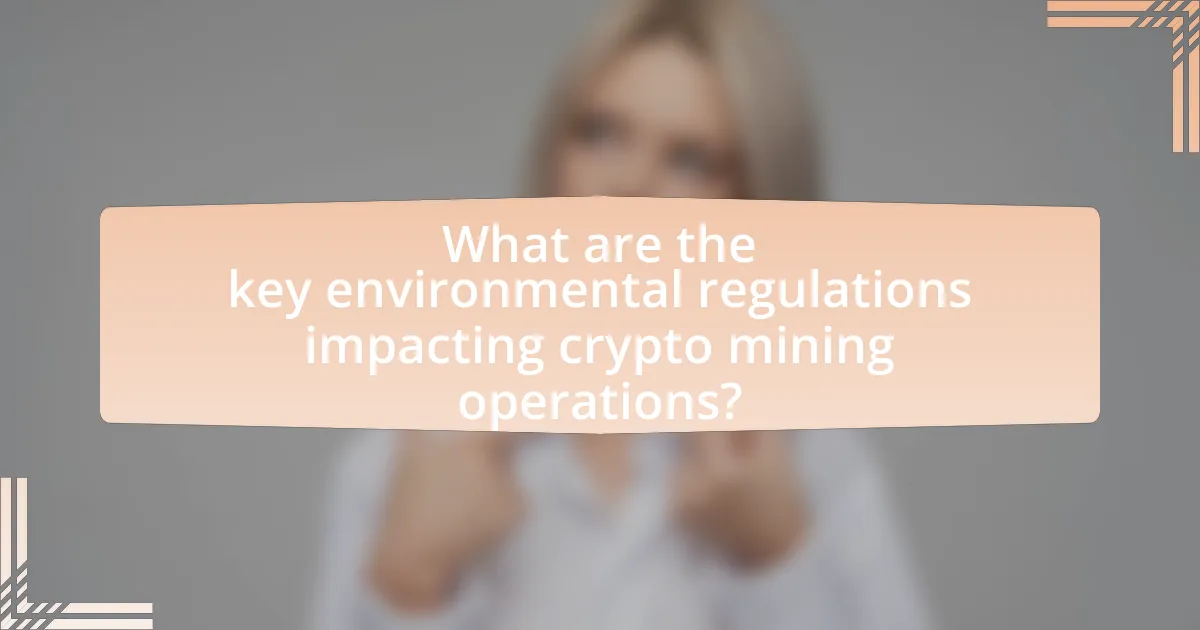The article focuses on the environmental regulations impacting crypto mining operations, highlighting key laws such as the Clean Air Act and Clean Water Act, as well as state-level energy regulations. It examines regional variations in these regulations, particularly in North America, Europe, and Asia, and discusses the primary environmental concerns associated with crypto mining, including high energy consumption and carbon emissions. The article also explores compliance strategies employed by mining companies, the role of renewable energy, and the influence of public perception and global climate agreements on regulatory frameworks. Additionally, it outlines best practices for miners to align with environmental standards and the importance of community engagement in regulatory compliance.

What are the key environmental regulations impacting crypto mining operations?
Key environmental regulations impacting crypto mining operations include the Clean Air Act, the Clean Water Act, and various state-level energy regulations. The Clean Air Act regulates emissions from power plants that supply energy to mining operations, while the Clean Water Act governs the discharge of pollutants into water bodies, which can affect cooling processes in mining facilities. Additionally, states like New York and Washington have implemented specific regulations targeting energy consumption and environmental impact, often requiring mining operations to adhere to strict energy efficiency standards and sustainability practices. These regulations aim to mitigate the environmental footprint of crypto mining, which is known for its high energy consumption and potential ecological harm.
How do these regulations vary by region?
Environmental regulations affecting crypto mining operations vary significantly by region, primarily due to differing governmental policies and environmental priorities. For instance, in the European Union, regulations are increasingly stringent, focusing on sustainability and carbon emissions, as seen in the EU’s Green Deal, which aims for climate neutrality by 2050. In contrast, regions like Texas in the United States have more lenient regulations, promoting crypto mining as a means to utilize excess energy from renewable sources, particularly wind and solar. Additionally, countries such as China have imposed outright bans on crypto mining due to environmental concerns and energy consumption, while other nations, like Canada, have adopted a more balanced approach, encouraging mining operations that utilize renewable energy sources. These regional differences highlight the diverse regulatory landscapes that crypto mining operations must navigate globally.
What specific laws govern crypto mining in North America?
Specific laws governing crypto mining in North America include federal, state, and local regulations that address environmental impacts, energy consumption, and taxation. For instance, in the United States, the Clean Air Act and the Clean Water Act impose regulations on emissions and discharges from mining operations, while states like New York have enacted moratoriums on new mining permits to assess environmental effects. Additionally, some states offer incentives for renewable energy use in mining, such as Texas, which has favorable regulations for energy-intensive operations. These laws are designed to mitigate the environmental footprint of crypto mining and ensure compliance with energy regulations.
What environmental policies are in place in Europe regarding crypto mining?
Europe has implemented various environmental policies regarding crypto mining, primarily focusing on energy consumption and emissions reduction. The European Union’s Green Deal aims to make Europe climate-neutral by 2050, which includes regulations that affect energy-intensive industries like crypto mining. Additionally, the EU has proposed the Markets in Crypto-Assets Regulation (MiCA), which emphasizes sustainability and requires crypto projects to disclose their environmental impact. Countries such as Norway and Sweden have also introduced specific measures, including higher electricity taxes for energy-intensive operations, to discourage excessive energy use in crypto mining. These policies are designed to mitigate the environmental impact of crypto mining by promoting energy efficiency and the use of renewable energy sources.
How do regulations in Asia differ from those in other regions?
Regulations in Asia regarding crypto mining operations often emphasize stricter environmental controls compared to other regions. For instance, countries like China have implemented significant restrictions on crypto mining due to concerns over energy consumption and carbon emissions, leading to a crackdown on mining activities in regions reliant on coal power. In contrast, regions such as North America and Europe may adopt more lenient regulations, focusing on promoting innovation while encouraging sustainable practices without outright bans. This divergence is evident in the varying approaches to energy sources, with Asia prioritizing immediate environmental impacts, while other regions may balance economic growth with environmental considerations.
What are the primary environmental concerns associated with crypto mining?
The primary environmental concerns associated with crypto mining include high energy consumption, carbon emissions, and electronic waste. Crypto mining, particularly for currencies like Bitcoin, requires substantial computational power, leading to significant electricity usage; for instance, Bitcoin mining alone consumes more energy than some countries, with estimates around 100 terawatt-hours annually. This energy demand often relies on fossil fuels, contributing to increased carbon emissions, which exacerbate climate change. Additionally, the hardware used in mining has a limited lifespan, resulting in electronic waste that poses disposal and recycling challenges, further impacting the environment.
How does energy consumption from crypto mining affect the environment?
Energy consumption from crypto mining significantly affects the environment by contributing to increased greenhouse gas emissions and depleting natural resources. The process of mining cryptocurrencies, particularly those using proof-of-work algorithms, requires substantial computational power, which in turn demands large amounts of electricity. For instance, a study by the Cambridge Centre for Alternative Finance reported that Bitcoin mining alone consumes around 130 terawatt-hours of electricity annually, comparable to the energy usage of entire countries like Argentina. This high energy demand often relies on fossil fuels, leading to higher carbon emissions and exacerbating climate change. Additionally, the extraction of resources for mining hardware can result in habitat destruction and increased electronic waste, further harming ecosystems.
What role does carbon emissions play in the assessment of crypto mining operations?
Carbon emissions are a critical factor in the assessment of crypto mining operations, as they directly impact environmental sustainability and regulatory compliance. The energy-intensive nature of crypto mining, particularly for proof-of-work cryptocurrencies, leads to significant carbon emissions, especially when fossil fuels are the primary energy source. For instance, a study by the Cambridge Centre for Alternative Finance indicates that Bitcoin mining alone contributes approximately 0.5% of global electricity consumption, which correlates with substantial greenhouse gas emissions. Regulatory bodies increasingly consider these emissions when evaluating the environmental impact of mining operations, leading to stricter regulations aimed at reducing carbon footprints. Consequently, the level of carbon emissions can influence operational costs, public perception, and the overall viability of mining projects in a landscape increasingly focused on sustainability.
How does water usage in crypto mining impact local ecosystems?
Water usage in crypto mining significantly impacts local ecosystems by depleting water resources and altering aquatic habitats. The high energy demands of mining operations often require substantial cooling systems that utilize large volumes of water, which can lead to reduced water availability for local flora and fauna. For instance, a study by the University of California, Berkeley, found that certain mining facilities can consume up to 1.5 million gallons of water per day, stressing nearby water supplies and affecting local biodiversity. Additionally, the discharge of heated water back into natural bodies can disrupt temperature-sensitive aquatic ecosystems, further threatening species that rely on stable conditions.

How do crypto mining operations comply with environmental regulations?
Crypto mining operations comply with environmental regulations by implementing energy-efficient technologies and utilizing renewable energy sources. Many mining facilities are transitioning to renewable energy, such as solar, wind, and hydroelectric power, to reduce their carbon footprint and meet regulatory standards. For instance, a report from the Cambridge Centre for Alternative Finance indicates that as of 2021, approximately 56% of Bitcoin mining was powered by renewable energy. Additionally, some operations are adopting advanced cooling systems and optimizing hardware to minimize energy consumption, further aligning with environmental guidelines. These measures not only help in compliance but also enhance the sustainability of mining practices.
What strategies do mining companies use to meet regulatory requirements?
Mining companies employ several strategies to meet regulatory requirements, including compliance audits, environmental impact assessments, and stakeholder engagement. Compliance audits help ensure that operations align with local, national, and international regulations, while environmental impact assessments evaluate potential effects on ecosystems before project initiation. Additionally, stakeholder engagement involves collaborating with local communities and regulatory bodies to address concerns and incorporate feedback, which fosters transparency and accountability. These strategies are essential for maintaining operational licenses and avoiding legal penalties, as evidenced by the increasing scrutiny of mining practices in various jurisdictions.
How can renewable energy sources be integrated into crypto mining?
Renewable energy sources can be integrated into crypto mining by utilizing solar, wind, and hydroelectric power to supply the energy needed for mining operations. For instance, solar panels can be installed at mining facilities to harness sunlight, while wind turbines can generate electricity in areas with consistent wind patterns. Hydroelectric power can also be tapped by locating mining operations near rivers or dams. According to a report by the International Energy Agency, renewable energy accounted for nearly 30% of global electricity generation in 2020, indicating a significant potential for crypto mining to adopt these sustainable sources. By transitioning to renewable energy, crypto mining can reduce its carbon footprint and align with environmental regulations aimed at minimizing greenhouse gas emissions.
What technologies are available to reduce the environmental impact of mining?
Technologies available to reduce the environmental impact of mining include renewable energy sources, advanced water management systems, and waste recycling techniques. Renewable energy sources, such as solar and wind power, can significantly lower greenhouse gas emissions associated with mining operations. Advanced water management systems, including closed-loop water recycling, minimize water usage and reduce contamination of local water sources. Waste recycling techniques, such as the recovery of metals from electronic waste, help decrease the volume of waste generated and promote resource efficiency. These technologies collectively contribute to more sustainable mining practices and mitigate environmental degradation.
What challenges do crypto miners face in adhering to environmental regulations?
Crypto miners face significant challenges in adhering to environmental regulations primarily due to high energy consumption and reliance on fossil fuels. The process of mining cryptocurrencies, particularly Bitcoin, requires substantial computational power, leading to increased electricity usage. According to the Cambridge Centre for Alternative Finance, Bitcoin mining consumes approximately 130 terawatt-hours of electricity annually, comparable to the energy consumption of entire countries.
Additionally, many mining operations are located in regions where electricity is generated from non-renewable sources, contributing to higher carbon emissions. Regulatory frameworks often mandate reductions in greenhouse gas emissions, which can conflict with the operational needs of miners. Furthermore, the lack of standardized regulations across different jurisdictions complicates compliance, as miners must navigate varying requirements and potential penalties. These factors collectively hinder crypto miners’ ability to meet environmental standards effectively.
How do fluctuating regulations affect mining operations?
Fluctuating regulations significantly impact mining operations by creating uncertainty and increasing operational costs. When regulations change frequently, mining companies must adapt their practices to comply, which can lead to delays in project timelines and increased expenditures on compliance measures. For instance, in 2021, China’s crackdown on cryptocurrency mining led to the closure of numerous mining facilities, resulting in a substantial decrease in global hash rate and forcing miners to relocate to more favorable jurisdictions. This illustrates how regulatory shifts can disrupt operations and influence market dynamics.
What are the financial implications of compliance for mining companies?
Compliance for mining companies incurs significant financial implications, including increased operational costs, potential fines, and investment in sustainable technologies. For instance, adhering to environmental regulations often requires substantial capital expenditures on equipment upgrades and waste management systems, which can strain budgets. Additionally, non-compliance can lead to hefty fines; in 2020, the Environmental Protection Agency imposed over $1 billion in penalties across various industries, including mining. Furthermore, companies may face increased insurance premiums and legal costs associated with compliance audits and potential litigation. These financial burdens can impact profitability and long-term viability, necessitating strategic planning to balance compliance with operational efficiency.

What future trends are emerging in environmental regulations for crypto mining?
Future trends in environmental regulations for crypto mining include increased scrutiny on energy consumption, a shift towards renewable energy sources, and stricter emissions standards. Regulatory bodies are focusing on the environmental impact of crypto mining, as evidenced by initiatives in countries like China and the European Union, which have implemented or proposed regulations aimed at reducing carbon footprints associated with mining operations. For instance, the EU’s proposed regulations on digital assets emphasize sustainability, requiring miners to disclose energy usage and carbon emissions. Additionally, there is a growing trend towards incentivizing the use of renewable energy, as seen in regions like Texas, where miners are encouraged to utilize excess renewable energy. These trends indicate a significant shift towards more sustainable practices in the crypto mining industry.
How might global climate agreements influence crypto mining regulations?
Global climate agreements may lead to stricter regulations on crypto mining by mandating reductions in carbon emissions and promoting sustainable energy use. For instance, agreements like the Paris Accord aim to limit global warming, which could pressure countries to enforce regulations that require crypto mining operations to utilize renewable energy sources. As a result, jurisdictions may impose higher energy efficiency standards and carbon taxes on mining activities, reflecting the commitments made in these international agreements. This trend is already observable in regions like the European Union, where regulatory frameworks are evolving to align with climate goals, thereby directly impacting the operational landscape for crypto miners.
What potential changes in legislation could impact the industry?
Potential changes in legislation that could impact the crypto mining industry include stricter environmental regulations aimed at reducing carbon emissions and energy consumption. For instance, governments may implement policies that require crypto miners to use renewable energy sources, as seen in countries like China, which has previously banned mining operations due to environmental concerns. Additionally, new regulations could impose higher taxes on energy-intensive operations or mandate carbon credits for emissions, similar to the European Union’s Emissions Trading System. These legislative changes are designed to address climate change and promote sustainable practices within the industry.
How are public perceptions of crypto mining shaping regulatory frameworks?
Public perceptions of crypto mining significantly influence regulatory frameworks by prompting governments to address environmental concerns associated with mining activities. As public awareness grows regarding the high energy consumption and carbon footprint of crypto mining, regulatory bodies are increasingly pressured to implement stricter environmental regulations. For instance, in 2021, New York State proposed a moratorium on certain types of crypto mining operations to assess their environmental impact, reflecting public sentiment about sustainability. This response illustrates how negative public perceptions can lead to legislative actions aimed at mitigating environmental harm, thereby shaping the regulatory landscape for crypto mining.
What best practices can crypto miners adopt to align with environmental regulations?
Crypto miners can adopt renewable energy sources, such as solar or wind power, to align with environmental regulations. Utilizing renewable energy significantly reduces carbon emissions associated with mining operations, which is crucial as the global energy consumption of Bitcoin mining alone was estimated to be around 97 TWh in 2021, comparable to the energy consumption of the Netherlands. Additionally, implementing energy-efficient mining hardware can further decrease energy usage and enhance compliance with regulations aimed at reducing environmental impact. By adopting these practices, miners not only comply with regulations but also contribute to a more sustainable future for the industry.
How can miners effectively monitor their environmental impact?
Miners can effectively monitor their environmental impact by implementing real-time data tracking systems that measure energy consumption, emissions, and water usage. These systems utilize sensors and software to collect data on the operational processes, allowing miners to assess their carbon footprint and resource utilization continuously. For instance, a study by the International Energy Agency in 2021 highlighted that integrating IoT technology in mining operations can reduce energy consumption by up to 30%, thereby minimizing environmental impact. Additionally, regular audits and compliance checks against environmental regulations can ensure that mining activities align with sustainability goals, further reinforcing the effectiveness of monitoring practices.
What role does community engagement play in regulatory compliance?
Community engagement plays a crucial role in regulatory compliance by fostering transparency and collaboration between organizations and stakeholders. Engaging with the community allows companies to understand local concerns, which can lead to more effective compliance with environmental regulations. For instance, research indicates that organizations that actively involve community members in decision-making processes are more likely to adhere to regulatory standards, as they can address potential issues proactively. This engagement not only builds trust but also enhances the legitimacy of the regulatory framework, as seen in various case studies where community feedback has led to improved environmental practices in industries, including crypto mining.